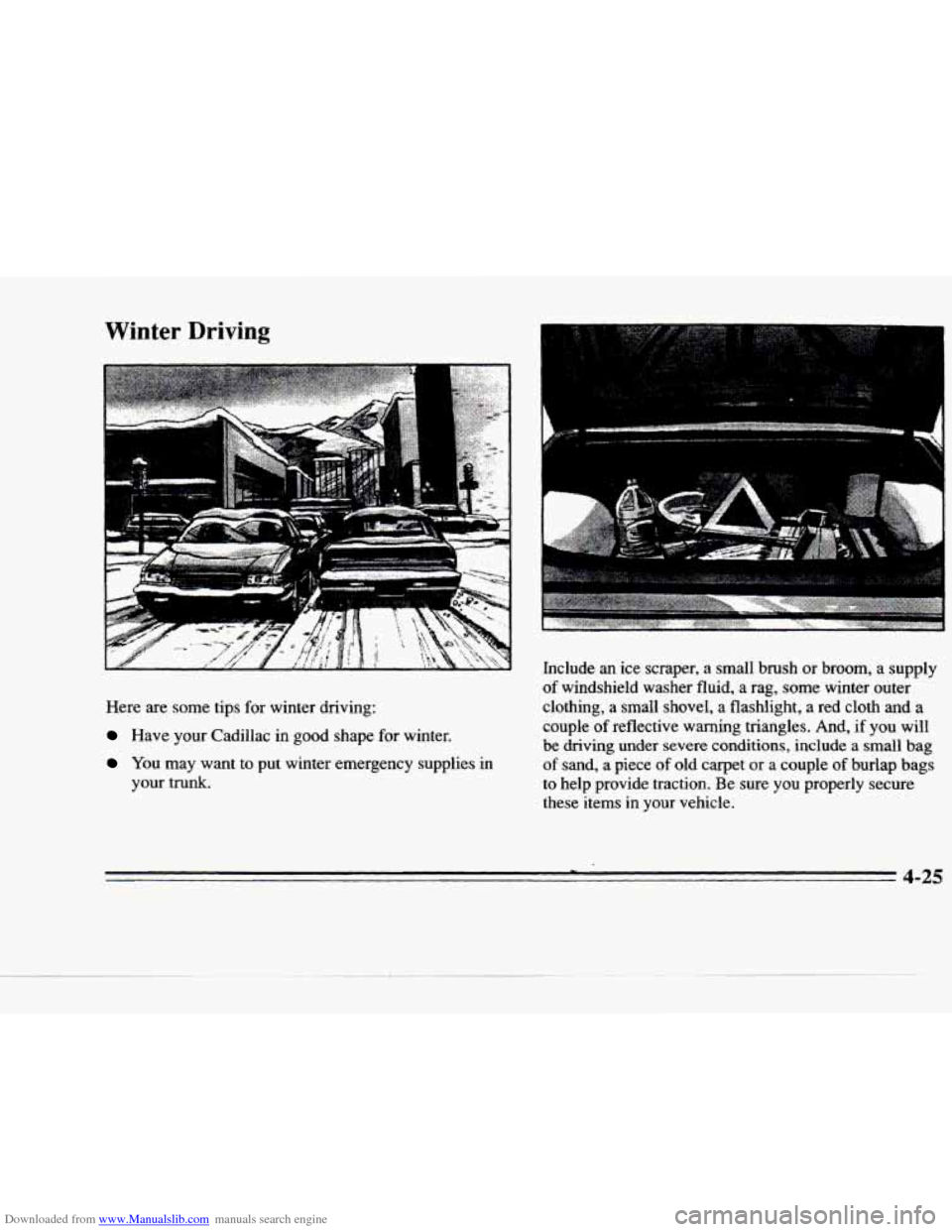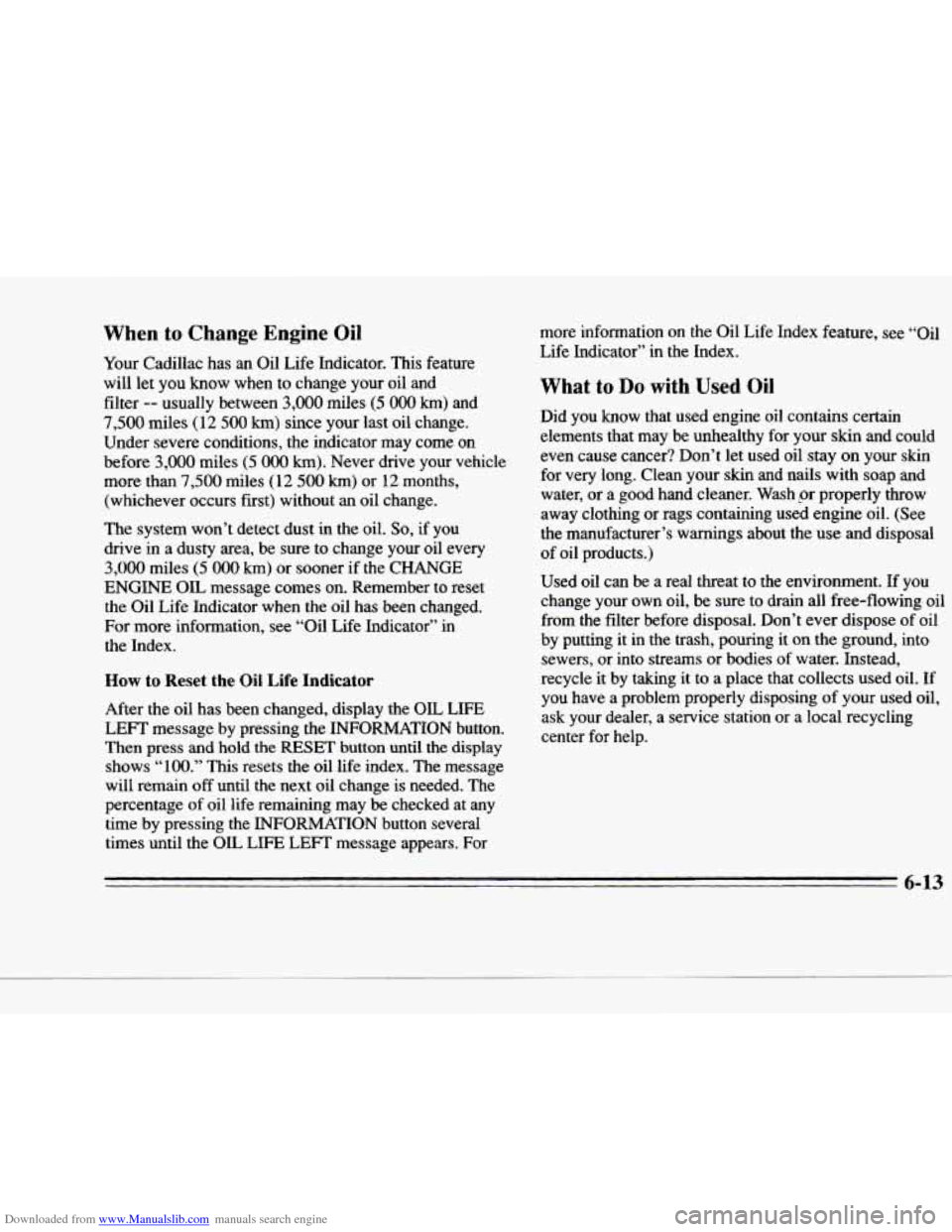warning CADILLAC DEVILLE 1996 7.G Owner's Manual
[x] Cancel search | Manufacturer: CADILLAC, Model Year: 1996, Model line: DEVILLE, Model: CADILLAC DEVILLE 1996 7.GPages: 354, PDF Size: 20.32 MB
Page 206 of 354

Downloaded from www.Manualslib.com manuals search engine Winter Driving
Here are some tips for winter driving:
Have your Cadillac in good shape for winter.
You may want to put winter emergency supplies in
your trunk.
Include an ice scraper, a small brush or broom, a supply
of windshield washer fluid, a rag, some winter outer
clothing,
a small shovel, a flashlight, a red cloth and a
couple of reflective warning triangles. And, if you will
be driving under severe conditions, include a small bag
of sand, a piece
of old carpet or a couple of burlap bags
to help provide traction. Be sure
you properly secure
these items
in your vehicle.
Page 224 of 354

Downloaded from www.Manualslib.com manuals search engine c
w
Section 5 Problems on the Road
Here you'll find what to do about some problems that
can occur on the road.
Hazard Warning Flashers
r- .. , . , .:.. :.
Your hazard warning flashers let you warn others. They
also let police
know you have a problem. Your front and
rear turn signal lamps will flash on and off.
Press the button in to make the front and rear turn signal
lamps flash
on and off.
5-1
Page 225 of 354

Downloaded from www.Manualslib.com manuals search engine A
This light on the instrument
panel will flash indicating that the hazard warning
flashers are on.
The hazard warning flashers will work once the button
is
pressed in regardress of the key position.
Pull out on the
collar to turn the flashers off. When the
hazard warning flashers
are on, the turn signals won't
work since they
are already flashing.
5-2
Page 226 of 354

Downloaded from www.Manualslib.com manuals search engine c
P
e
Other Warning Devices
If you carry reflective triangles, you can set one up at
the side of the road about
300 feet (100 m) behind your
vehicle.
Jump Starting
If your battery has run down, you may want to use
another vehicle and some jumper cables
to start your
Cadillac. Please follow the steps below to do it safely.
NOTICE:
Ignoring these steps could result in costly damage
to your vehicle that wouldn’t be covered by your
warranty.
Trying to
start your Cadillac by pushing or
pulling it won’t work and it could damage your
vehicle.
A CAUTION:
Batteries can hurt you. They can be dangerous
because:
They contain acid that can burn you.
They contain gas that can explode or ignite.
They contain enough electricity to burn you.
If you don’t follow these steps exactly, some or all
of these things can hurt you.
1. Check the other vehicle. It must have a 12-volt
battery with a negative ground system.
I NOTICE: I
If the other system isn’t a 12-volt system with a
negative ground, both vehicles can be damaged.
5-3
Page 231 of 354

Downloaded from www.Manualslib.com manuals search engine Towing Your Vehicle
Try to have a Cadillac dealer or a professional towing
service
tow your DeVille. See “Roadside Assistance” in
the Index.
If your vehicle has been changed or modified since it
was factory-new by adding aftermarket items like fog
lamps, aero skirting or special tires and wheels, these
instructions
may not be correct.
Before you do anything, turn on the hazara warning
flashers.
When
you call, tell the towing service:
That your vehicle has front-wheel drive.
The make, model and year of your vehicle.
Whether you can still move the shift lever.
If there was an accident, what was damaged. Front Towing
When the towing service arrives, let the tow operator know
that this manual contains towing instructions and
illustrations. The operator may want to see them.
5-8 -
Page 238 of 354

Downloaded from www.Manualslib.com manuals search engine Engine Overheating
You will find an ENGINE COOLANT HOT-IDLE
ENGINE message
or a STOP ENGINE ENGINE
OVERHEATED message on the DIC. There is also an
engine temperature warning light
on the instrument
panel. See “Engine Temperature Warning Light” in the
Index.
Overheated Engine Protection Operating
Mode
Y
Should a low coolant condition exist and the message
STOP ENGINE
ENGINE OVERHEATED is displayed,
an overheat protection mode which alternates firing
groups
of four cylinders helps prevent engine damage.
This operating mode
allows your vehicle to be driven
to a safe place in
an emergency; you may drive up to
50 miles (80 km). Towing a trailer in the overheat
protection mode should be avoided.
I NOTICE:
After driving in the Overheated Engine
Protection Operating Mode,
to avoid engine
damage, allow the engine to cool before
attempting any repair. The engine oil may be
severely degraded. Change the
oil and reset the
oil life indicator. See “Engine Oil, When to
~ Change” in the Index.
P
Page 240 of 354

Downloaded from www.Manualslib.com manuals search engine If No Steam Is Coming From Your Engine
If you get the overheat warning but see or hear no
steam, the problem may not
be too serious. Sometimes
the engine can get a little too hot when you:
Climb a long hill on a hot day.
Stop after high-speed driving.
0 Idle for long periods in traffic.
Tow a trailer.
c
c
If you get the overheat warning with no sign of steam,
try this for
a minute or so:
1. Turn off your air conditioner.
2. Dial temperature control to the highest heat setting and open the window, as necessary.
3. If you’re in a traffic jam, shift to NEUTRAL (N);
otherwise, shift to the highest gear while
driving
-- OVERDRIVE (a) or THIRD (3).
If you no longer have the overheat warning, you can
drive. Just to be safe, drive slower for about 10 minutes,
If the warning doesn’t come back on, you can drive
nonnally.
If the warning continues, pull over, stop
and park your
vehicle right away.
If there’s still no sign of steam, you can idle the engine
for two
or three minutes while you’re parked, to see if
the warning stops.
But then, if you still have the
warning,
turn off the engine and get everyone out of the
vehicle
until it cools down. Also, see “Overheated
Engine Protection Operating Mode” listed previously in
this section.
You may decide not to lift the hood but to get &mice
help right away.
5-17
Page 244 of 354

Downloaded from www.Manualslib.com manuals search engine c
A CAUTION:
Adding only plain water to your cooling system
can be dangerous. Plain water, or some other
liquid like alcohol,
can boil before the proper
coolant mix will. Your vehicle's coolant warning
system
is set for the proper coolant mix. With
plain water or the wrong mix, your engine could
get too hot but you wouldn't
get the overheat
warning. Your engine could catch fire and you
or
others could be burned. Use a 50/50 mix of clean
water and
DEX-COOL TM antifreeze.
5-21
c
Page 248 of 354

Downloaded from www.Manualslib.com manuals search engine c
LI
c
c
If a Tire Goes Flat
It’s unusual for a tire to “blow out” while you’re driving,
especially if you maintain
your tires properly. If air goes
out of
a tire, it’s much more likely to leak out slowly.
But if
you should ever have a “blowout,” here are a few
tips about what to expect and
what to do:
If a front tire fails, the flat tire will create a drag that
pulls the vehicle toward that side. Take your foot
off the
accelerator pedal and grip the steering wheel firmly.
Steer to maintain lane position, and then gently brake to
a stop well out
of the traffic lane.
A rear blowout, particularly on a curve, acts much like a
skid and
may require the same correction you’d use in a
skid. In any rear blowout, remove your foot from the
accelerator pedal. Get the vehicle under control
.by
steering the way you want the vehicle to go. It may be
very bumpy and noisy, but you can still steer. Gently
brake
to a stop -- well off the road if possible.
If a tire goes flat, the next
part shows how to use your
jacking equipment
to change a flat tire safely.
Changing a Flat Tire
If a tire goes flat, avoid further tire and wheel damage
by driving slowly to
a level place. Turn on your hazard
warning flashers.
A CAUTION:
~~
Changing a tire can cause an injury. The vehicle
can slip
off the jack and roll over you or.other
people. You and they could be badly injured.
Find
a level place to change your tire. To help
prevent the vehicle from moving:
1. Put the shift lever in PARK (P).
2. Set the parking brake firmly.
3. lhrn off the engine.
To be even more certain the vehicle won’t move,
you can put blocks
at the front and rear of the
tire farthest
away from the one being changed.
That
would be the tire on the other side of the
vehicle, at the opposite end.
5-25
Page 274 of 354

Downloaded from www.Manualslib.com manuals search engine CI
c-
c
When to Change Engine Oil
Your Cadillac has an Oil Life Indicator. This feature
will let you know when to change your oil and
filter
-- usually between 3,000 miles (5 000 km) and
7,500 miles (12 500 km) since your last oil change.
Under severe conditions, the indicator may come on
before
3,000 miles (5 OOO km). Never drive your vehicle
more than
7,500 miles (12 500 km) or 12 months,
(whichever occurs first) without an oil change.
The system won’t detect dust in the oil.
So, if you
drive in a dusty area, be sure to change your oil every
3,000 miles (5 000 km) or sooner if the CHANGE
ENGINE OIL message comes on. Remember to reset
the
Oil Life Indicator when the oil has been changed.
For more information, see “Oil Life Indicator”
in
the Index.
How to Reset the Oil Life Indicator
After the oil has been changed, display the OIL LIFE
LEFT message by pressing the INFORMATION button.
Then press and hold the RESET button until the display
shows
“100.” This resets the oil life index. The message
will remain off until the next oil change is needed. The
percentage of oil life remaining may be checked at any
time by pressing the INFORMATION button several
times until the
OIL LIFE LEFT message appears. For more information
on the Oil Life Index
feature, see “oil
Life Indicator” in the Index.
What to Do with Used Oil
Did you know that used engine oil contains certain
elements that may be unhealthy for your skin and could
even cause cancer? Don’t let used oil stay
on your skin
for very long. Clean your skin and nails with soap and
water, or a good hand cleaner. Wash
;or properly throw
away clothing
or rags containing used engine oil. (See
the manufacturer’s warnings about the use
and disposal
of oil products.)
Used oil can be a real threat to the environment. If you
change your own oil, be sure to drain
all free-flowing oil
from the filter before disposal. Don’t ever dispose of oil
by putting it in the trash, pouring it on the ground, into
sewers, or into streams or bodies of water. Instead,
recycle
it by taking it to a place that collects used oil. If
you have a problem properly disposing
of your used oil,
ask your dealer, a service station or a local recycling
center for help.
6-13